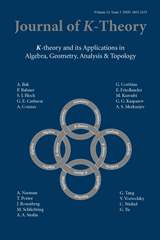Article contents
Cyclic multicategories, multivariable adjunctions and mates
Published online by Cambridge University Press: 02 January 2014
Abstract
A multivariable adjunction is the generalisation of the notion of a 2-variable adjunction, the classical example being the hom/tensor/cotensor trio of functors, to n + 1 functors of n variables. In the presence of multivariable adjunctions, natural transformations between certain composites built from multivariable functors have “dual” forms. We refer to corresponding natural transformations as multivariable or parametrised mates, generalising the mates correspondence for ordinary adjunctions, which enables one to pass between natural transformations involving left adjoints to those involving right adjoints. A central problem is how to express the naturality (or functoriality) of the parametrised mates, giving a precise characterization of the dualities so-encoded.
We present the notion of “cyclic double multicategory” as a structure in which to organise multivariable adjunctions and mates. While the standard mates correspondence is described using an isomorphism of double categories, the multivariable version requires the framework of “double multicategories”. Moreover, we show that the analogous isomorphisms of double multicategories give a cyclic action on the multimaps, yielding the notion of “cyclic double multicategory”. The work is motivated by and applied to Riehl's approach to algebraic monoidal model categories.
- Type
- Research Article
- Information
- Copyright
- Copyright © ISOPP 2013
References
- 10
- Cited by


